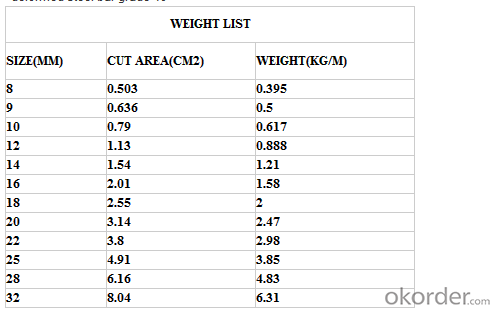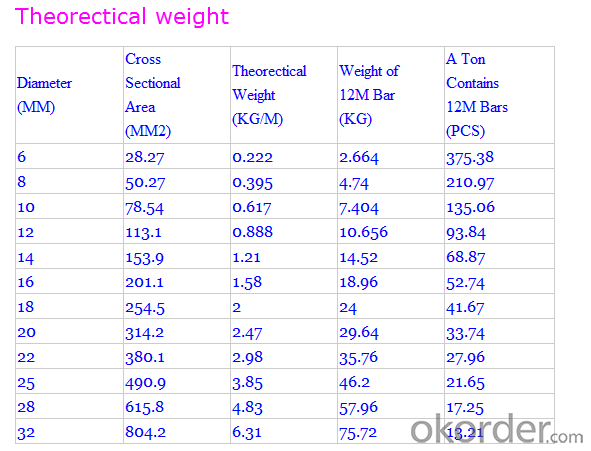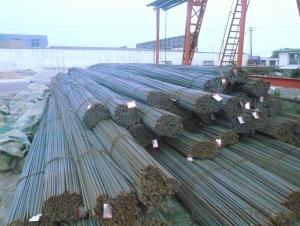Hot-Rolled Steel Deformed Bar,Rebar,Deformed Steel Bar
- Loading Port:
- Shanghai
- Payment Terms:
- TT OR LC
- Min Order Qty:
- 100 m.t.
- Supply Capability:
- 1000 m.t./month
OKorder Service Pledge
OKorder Financial Service
You Might Also Like
deformed steel bar grade 40
material: HRB400, BS4449 GR460B
size: 8-36mmx12m.
short delivery time by bulk or container
deformed steel bar grade 40
material: HRB400, BS4449 GR460B
size: 8-36mmx12m.
short delivery time with bulk or container
packing: Mill standard export packing in bundles/coil, around 2tons/bundle.
country of Origin: China
delivery Time: Within a 35 days
Shipment: by bulk vessel or by container

Leading goods:
section steel:angles,channels,I-beam,H-beam;
coils:cold/hot rolled coils,PPGI,galvanized coils,plate,checkered plate,cutting steel plate,steel strip;
wire rod:steel wire,deformed wire,bar;
pipe:seamless pipe,rectangular pipe,welded pipe,spiral welded pipe,pipe fittings;
stainless steel:steel sheets,stainless steel strips,stainless bar,stainless tube;
special:weathering steel,shipbuilding steel;
construction steel:C-channel,Z-channel,T-bar,high-speed divider plate,corrugated steel plate,steel grating.
Advantage:
We are the spot supplier, Six huge warehouses which can hold 20,000 MT goods.
It makes the cost lower than others,we can provide the competitive price for you.
Delivery time:
Normal sizes can be provided in 7days, the others should be ready in 30---45 days.
Further treatment:
We can offer cutting,painting,drilling holes,bending,threading, welding,galvanization,packing etc.
Security interest:
We have already passed the ISO9001, BV and SGS authentication which makes the quality secured.
If you have the interest in any of the products we can provided, pls don't hesitate to connect with me. Looking forward to cooperate with you.

FAQ of Steel Deformed Bar
1. More than 10 years experience in this industry
2. 100,000 tons exporting per month
3. Professional foreign trade tea
4. OEM&ODM capacity
5. High quality assured & competitive price
6. Try our best to meet your needs & save your budget
7. Very popular in Southeast Asia, Africa, Mid-East and South America etc.
8. VIP membership system, first time customers and long-term cooperation customers can get extra discount on some products.
- Q:How do steel rebars contribute to the fire resistance of a structure?
- Steel rebars contribute to the fire resistance of a structure by providing strength and stability to the building's concrete components. In the event of a fire, the rebars help prevent the concrete from cracking or collapsing under high temperatures. The steel has a high melting point, which allows it to maintain its structural integrity even in intense heat. This prolongs the time before the structure reaches its critical failure point, giving occupants more time to evacuate and firefighters more time to control the fire.
- Q:How do steel rebars perform in fire-resistant constructions?
- Steel rebars perform well in fire-resistant constructions due to their high melting point and thermal conductivity. They can withstand high temperatures for an extended period without significant deformation or loss of strength. This makes them suitable for reinforcing concrete structures in fire-prone areas, providing stability and structural integrity during a fire. Additionally, the thermal conductivity of steel helps to dissipate heat, reducing the risk of localized temperature increases that could compromise the overall fire resistance of the construction.
- Q:Can steel rebars be used in marine construction projects?
- Yes, steel rebars can be used in marine construction projects. They are commonly used to reinforce concrete structures in marine environments due to their high strength, durability, and resistance to corrosion. However, it is important to use corrosion-resistant steel rebars or apply protective coatings to prevent rusting and maintain the structural integrity of the project.
- Q:Can steel rebars be used in other applications besides construction?
- Yes, steel rebars can indeed be used in other applications besides construction. Steel rebars are primarily used in construction to reinforce concrete structures and provide them with additional strength and durability. However, their properties and characteristics make them suitable for various other applications as well. One such application is in the manufacturing of bridges and highways. Steel rebars are commonly used in the construction of bridge decks and highway pavements to enhance their load-bearing capacity and resistance to cracking. Another application is in the automotive industry. Steel rebars can be used in the manufacturing of car frames and chassis to enhance the structural integrity and safety of vehicles. Additionally, steel rebars can be utilized in the production of various types of machinery and equipment where high strength and durability are required. This can include industrial machinery, agricultural equipment, and even appliances. Furthermore, steel rebars can also be employed in the production of sculptures and artworks due to their malleability and ability to hold intricate shapes. In summary, while the primary application of steel rebars is in construction, their properties make them versatile enough to be used in a range of other industries and applications.
- Q:What is the process of pre-stressing steel rebars?
- Steel rebars undergo a process called pre-stressing, wherein a predetermined amount of stress or force is applied to them before they are loaded. This technique is widely employed in the construction industry to enhance the structural strength and durability of concrete structures. The process typically commences with the selection of high-strength steel rebars that possess favorable tensile strength properties. These rebars are commonly crafted from either carbon steel or alloy steel and come in various shapes and sizes, depending on the specific application. Once the rebars are chosen, they are cleaned and coated with a protective layer to prevent corrosion. Subsequently, they are positioned as per the design specifications within the concrete structure, such as beams, columns, or slabs. Next, the pre-stressing process is initiated, which involves two main methods: pre-tensioning and post-tensioning. In pre-tensioning, the rebars are initially tensioned by being fixed to an anchorage point or a sturdy frame. The opposite end of the rebars is then pulled using hydraulic jacks or mechanical devices, exerting a substantial amount of force. Once the desired stress is attained, the rebars are secured in their stressed position by casting concrete around them. After the concrete solidifies, the jacks or devices are released, transferring the stress to the rebars. In post-tensioning, the rebars are initially placed in the concrete structure without any tension. After the concrete solidifies, ducts or channels are created within the structure along the path of the rebars. High-strength steel strands or cables are then inserted through these ducts. The strands are anchored at one end of the structure and tensioned using hydraulic jacks or similar devices. This tensioning process applies a force to the rebars, which is transferred to the concrete, compressing it. Once the desired stress is achieved, the strands are secured and the ducts are filled with grout or mortar for corrosion protection. Both pre-tensioning and post-tensioning techniques yield pre-stressed steel rebars that offer several advantages to concrete structures. These include increased load-carrying capacity, improved resistance to cracking and deformation, enhanced durability, and overall superior structural performance. The process of pre-stressing steel rebars is an essential aspect of modern construction practices, guaranteeing the longevity and safety of various types of concrete structures.
- Q:How are steel rebars handled and installed in congested reinforcement areas?
- Steel rebars are handled and installed in congested reinforcement areas by using specialized equipment and techniques. This typically involves carefully planning and coordinating the placement of rebars to ensure they fit within the limited space available. Additionally, smaller rebars may be used, and alternative methods such as pre-fabricated cages or splicing techniques may be employed to optimize the installation process. Overall, a combination of precise planning, skilled labor, and innovative approaches is necessary to handle and install steel rebars in congested reinforcement areas.
- Q:Are steel rebars suitable for use in tunnels and underground mines?
- Yes, steel rebars are suitable for use in tunnels and underground mines. Steel rebars, also known as reinforcement bars, are commonly used in construction for their strength and durability. In tunnels and underground mines, where structural integrity is crucial, steel rebars provide the necessary reinforcement to withstand the heavy loads and pressures associated with these environments. Steel rebars have excellent tensile strength, which allows them to resist bending and cracking under high stress. This is particularly important in tunnels and underground mines, where the surrounding rock and soil can exert significant pressure on the structure. By reinforcing the concrete or other structural materials with steel rebars, the overall strength and stability of the tunnel or mine are enhanced, reducing the risk of collapse or damage. Furthermore, steel rebars are resistant to corrosion, making them suitable for use in underground environments where moisture and chemical exposure are common. Corrosion can weaken the structural integrity of reinforcement materials, compromising the safety of the tunnel or mine. Steel rebars, on the other hand, provide long-lasting reinforcement, ensuring the longevity and reliability of the infrastructure. In addition, steel rebars can be easily fabricated and installed, making them a convenient choice for tunnel and underground mine construction. They can be cut and bent to specific shapes and sizes, allowing for customized reinforcement solutions that meet the unique requirements of each project. This versatility and ease of installation make steel rebars a practical choice for tunnels and underground mines, where complex geometries and challenging conditions are often encountered. Overall, steel rebars are well-suited for use in tunnels and underground mines due to their strength, durability, corrosion resistance, and ease of installation. By using steel rebars as reinforcement, these structures can be built to withstand the demanding conditions and ensure the safety of workers and the longevity of the infrastructure.
- Q:Can steel rebars be bent on site?
- Yes, steel rebars can be bent on site using specialized tools and equipment such as rebar benders.
- Q:How do steel rebars affect the overall strength of a structure?
- Steel rebars significantly enhance the overall strength of a structure by providing reinforcement and increasing its tensile strength. They act as a skeleton within the concrete, distributing the load more evenly and preventing cracks or failures.
- Q:Are steel rebars prone to bending or warping?
- Yes, steel rebars are prone to bending or warping under certain conditions. The flexibility and malleability of steel make it susceptible to bending or warping when subjected to excessive stress, temperature changes, or improper handling during construction or transportation. Proper reinforcement techniques and quality control measures can help minimize the risk of bending or warping in steel rebars.
1. Manufacturer Overview |
|
|---|---|
| Location | |
| Year Established | |
| Annual Output Value | |
| Main Markets | |
| Company Certifications | |
2. Manufacturer Certificates |
|
|---|---|
| a) Certification Name | |
| Range | |
| Reference | |
| Validity Period | |
3. Manufacturer Capability |
|
|---|---|
| a)Trade Capacity | |
| Nearest Port | |
| Export Percentage | |
| No.of Employees in Trade Department | |
| Language Spoken: | |
| b)Factory Information | |
| Factory Size: | |
| No. of Production Lines | |
| Contract Manufacturing | |
| Product Price Range | |
Send your message to us
Hot-Rolled Steel Deformed Bar,Rebar,Deformed Steel Bar
- Loading Port:
- Shanghai
- Payment Terms:
- TT OR LC
- Min Order Qty:
- 100 m.t.
- Supply Capability:
- 1000 m.t./month
OKorder Service Pledge
OKorder Financial Service
Similar products
New products
Hot products
Related keywords




























